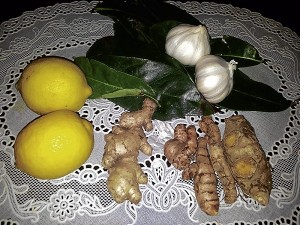Your backyard, neighborhood market as your ‘medicine cabinet’

NATURE’S natural remedies include lemon, ginger, guyabano leaves, garlic and turmeric (dilaw na luya). Photo by Tessa R. Salazar
LAST WEEK, Inquirer Science & Health featured literally down-to-earth home remedies for the common colds and flu. Experts suggested easing off the animal products and consuming more bioflavonoid-rich foods such as cabbage with hearts, and green peppers, parsley, carrots, broccoli, turnips, garlic, lemon juice, grapefruit and most fruits.
This time, the spotlight is on plant-based remedies even closer at hand. The Philippines is blessed with a variety of easily accessible vegetables and fruits that provide instant remedy to the sniffles. “The Medicinal Fruits and Vegetables” book by Dr. Jaime Galvez Tan and Ma. Rebecca Marana Galvez Tan cites locally available plants and herbs.
Alagaw, Atsuete (annat t.), Bayabas (guava), Dilaw (turmeric), Linga (sesame) and Luya (ginger) are the “cold busters.”
Cough remedies include Alagaw, Ampalaya (bitter gourd, African cucumber, balsam apple, balsam pear, tuberculated momordica), Asparagus, Atsuete, Balanoy (sweet basil), Balimbing, Bawang (garlic), Dayap (lime), Kalamansi (Chinese orange or Panama orange), Kamias, Luya (ginger), Mangga (mango), Mani (peanut, earth nut, ground nut, monkey nut), Niyog, Papaya (papau tree or pawpaw), Pili, Sampalok (tamarind) and Suha (grape-fruit pomelo or shaddock).
Fever fighters
The fever fighters are abukado (avocado), ampalaya, atsuete, balanoy, balimbing, bataw, bawang, bignay, carrot, dayap, gabi (tago), guyabano (soursop), kalamansi, kamias, kamoteng kahoy (tapioca), kasoy (cashew), kaymito (cainito or star apple), luya, mangostan (mangosteen), melon (musk melon or cantaloupe), niyog (coconut), papaya, pinya (pineapple), saging (banana), sampalok, and tsiko (chiku tree or sapodilla).
Due to space constraints, only dilaw (for colds), and ampalaya (for cough and fever) will be discussed at length here.
Turmeric (dilaw) is known for its anti-inflammatory properties. According to research findings, its antibacterial effect is greatest upon exposure to sunlight and skin application. Galvez Tan’s book cited that a Chinese study revealed that turmeric does lower blood cholesterol. It also points to a Chevalier study that reveals turmeric is a more potent antioxidant than vitamin E.
“Rhizome contains volatile oil, fat, starch, resin and curcumin pigment. Curcumin and its derivatives is responsible for inhibiting inflammation,” said Galvez Tan, referring to a Walker study.
Turmeric
Research has also shown that turmeric has anticoagulant and anticarcinogenic properties.
Traditionally, turmeric is classified into two rhizomes. The juice is applied for chest pain, sprains, swelling and joint pains, while the flower, made into poultice, is applied to ring worm infections.
Among the many health benefits of ampalaya (aside from its popular effects versus diabetes) is that its leaf extracts have been found to contain antibacterial properties, particularly against gram-positive bacteria. The traditional uses of ampalaya are classified into roots (decoction used for cleaning wounds); leaves (poultice applied for headache, juice given to children with cough), and fruit (juice to promote bowel movement).
For more details, e-mail jzgalveztan@gmail.com. The book is still locally available in all branches of National Bookstore and Fully Booked.
